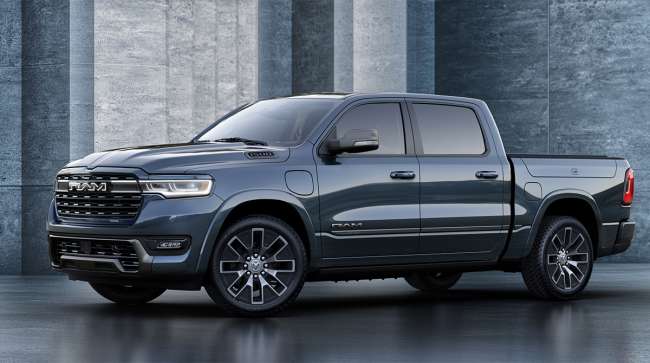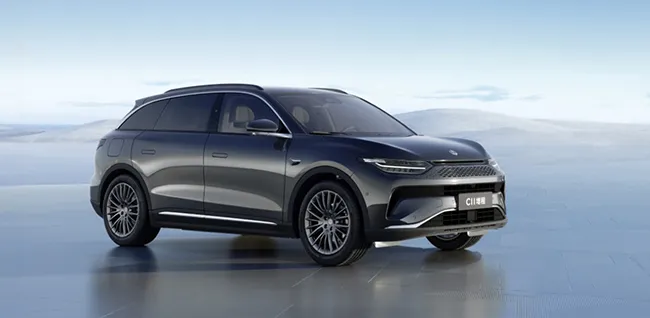The Detroit News
Alternative Powertrain Might Unlock US EV Market

[Stay on top of transportation news: Get TTNews in your inbox.]
An alternative vehicle powertrain that’s booming in China might hold the answer to encouraging Americans to adopt electric cars and trucks.
Extended-range electric vehicles, or EREVs, fully run off a battery like a traditional electric vehicle, but they carry an onboard generator — typically a gas-powered engine — that can recharge the battery. Unlike a hybrid, though, the engine doesn’t propel the vehicle.
The technology offers the performance benefits of an EV while alleviating range anxiety, easing recharging on long road trips, and allowing for a smaller battery that can help with affordability, weight and profitability challenges. The engine, however, does produce greenhouse gas emissions.
Stellantis NV is set to roll out its first EREV in the Ram 1500 Ramcharger truck, expected to begin production early next year, which the company says offers up to 690 miles of range. Ford Motor Co. executives have also, in recent appearances, discussed the benefits of the technology, though it typically takes a few years to develop a new vehicle. General Motors Co. has said it’s reintroducing plug-in hybrids to its North American lineup in 2027, but the automaker declined to comment on whether it’s considering EREV technology.
Customers who have placed a $100 reservation on Ram’s Insider+ program in the hopes of securing a Ramcharger say they like that it’s a vehicle they can run off electricity to reduce emissions most of the time while addressing their needs better than an all-electric vehicle can at this point.
Meet the All-New 2025 Ram 1500 Ramcharger. We’re changing the way people look at EV trucks. pic.twitter.com/RQLUfA1Li8 — Ram Trucks Canada (@RamTrucksCanada) November 17, 2023
Scott Poppers, 51, of Highland’s Ranch, Colo., became interested in getting an EV after his wife got a plug-in hybrid Kia Sorento. His needs, however, have prevented him from making the jump.
“I have a 6,000-pound trailer,” the engineer said. “There’s maybe a total of eight days of towing each year. It’s not much, but I don’t want to buy multiple vehicles. (The Ramcharger) is the first thing I’ve ever seen and still the only thing I have seen that can tow as an electric vehicle.”
He likes that he can recharge the battery with gasoline if needed, especially since there are areas going into the mountains or into New Mexico where even gasoline stations are sparse, let alone EV chargers.
Revving Up in China
It’s not just Americans who’ve found the concept appealing. Li Auto Inc. in China pioneered EREVs there, differentiating itself from other EV startups like Guangzhou Xiaopeng Motors Technology Co. Ltd., which does business as Xpeng, and Nio Inc., which focused on all-electric powertrains. Li was the first of those competitors to post an annual profit: $17.1 billion in 2023.
It sold more than 376,000 vehicles last year, up 182% year-over-year. In June, the brand sold 47,774 vehicles, up 47% year from June 2023. More than 20,000 came from the Li L6, a five-seat premium SUV that starts at $34,500.
“Li Auto has had spectacular sales in large part due to this drivetrain,” said Mike Dunne, a former GM executive who’s now CEO of consultancy Dunne Insights. “You have a spacious vehicle that can go long distances without stressing. It’s a pragmatic solution, an interim solution. It’s not the most elegant or most efficient from an environmental point of view. But it struck a chord with consumers.”
Competitors have noticed and are joining the fray. They include technology giant Huawei Technologies Co. Ltd.-backed Seres Group Co. Ltd., Volvo and Polestar parent Zhejiang Geely Holding Group Co. Ltd. and Ford partner Changan Automobile Co. Ltd.
In February, Stellantis partner Zhejiang Leapmotor Technology Co. Ltd., or Leapmotor, launched its first EREV, the C11 crossover. Volkswagen AG’s joint venture with SAIC Motor Corp. said in April it will launch EREVs, too.

In February, Stellantis partner Leapmotor launched its first EREV, the C11 crossover. (Leapmotor)
EREV wholesale shipments in June in China reached 116,000, up 113% from last year, according to the China Automobile Dealers Association. The popularity of EREVs and plug-in hybrids has eaten into the share of sales of all-electric vehicles. Their market share dropped 13 percentage points from a year earlier in June to 57%, while the share of range-extended EVs rose five percentage points to 12%.
EREV options in China can offer close to 1,000 miles of range. The roughly $56,500 flagship Li L9 luxury full-size SUV offers a combined range of 877 miles, including 174 miles from the battery without the generator. Carbon emissions of the six-seater L9 were 480 grams of carbon dioxide equivalent per mile (297.96 grams of carbon dioxide equivalent per kilometer), according to Li’s 2023 environmental, social and governance report.
Similarly, segmented internal combustion engine vehicles include the Mercedes-Benz GLS, BMW X7 and Cadillac Escalade. The U.S. Environmental Protection Agency lists greenhouse gas tailpipe emissions as 428 to 564 grams per mile for GLS vehicles, 392 to 506 grams per mile for X7 models and 442 to 682 grams per mile for Escalades. The Escalade, which seats up to seven, is getting an all-electric IQ model in 2025 that will start at $129,990.
EREVs in the United States
Now, seeing the success of EREVs in China, global automakers are looking at the technology, too.

Farley
“It has a smaller battery, and 95% of the trips are gonna be all-electric,” Ford CEO Jim Farley said about EREVs at the end of May at the Bernstein Annual Strategic Decisions Conference. “And then you don’t have range anxiety, and the infrastructure is taking time to fill out, so it’s a good solution. That’s why it’s popular in China. That’s why it’s doubled in sales in China, and we really like that solution.”
Ford Chief Financial Officer John Lawler said last month the Dearborn, Mich., automaker will leverage its partners in China to develop EREVs.
The technology isn’t exactly new to the United States. The Chevrolet Volt that was discontinued in 2019 operated as an EREV, though at higher speeds when the battery was depleted, the engine could propel the vehicle. The BMW i3 REx, which ended production in 2022, was also an EREV, though it used a motorcycle engine mostly configured as an emergency backup to charge the battery. The Fisker Karma that ended in 2012 had a range-extending generator as well.
Stellantis hasn’t shared when orders for the Ramcharger will open or what the pricing will be on it or the all-electric REV. The refreshed gas-powered 2025 Ram 1500 starts at $40,275.
The Ramcharger is expected to offer 145 miles from its battery and 545 miles from the battery being charged by a 3.6-liter Pentastar V-6 eTorque engine. In comparison, the all-electric Ram 1500 REV’s extended-range battery is slated to provide 500 miles when that vehicle launches in the fourth quarter. Ford’s extended-range all-electric F-150 Lightning truck offers 320 miles. A full charge is estimated to provide 450 miles to the Chevrolet Silverado EV 4WT.
Meanwhile, payload on the Ramcharger of up to 2,625 pounds is just shy of the REV’s, which is up to 2,700 pounds. Both have a 0-60 mph time of 4.4 seconds and towing capacity of up to 14,000 pounds.
The makers of Transport Topics' updated Top 100 For-Hire Carriers list examine how the freight market slump has altered the competitive landscape in trucking. Tune in above or by going to RoadSigns.ttnews.com.
But, the heavier the load, the more taxing that will be on an EV’s range. That’s why potential customers say they like the idea of the onboard gas generator.
“It’s clear that in terms of how much an electric truck can tow, that’s not an issue,” said Sam Abuelsamid, principal e-mobility analyst at market research firm Guidehouse Inc. “You can tow huge amounts. The problem is range. It’s a problem for gas trucks, as well. Larger trailers have a lot of aerodynamic drag.”
So, although a pickup’s mpg might be cut in half when towing, it at least can pull into the many available gas stations to fuel up quickly. That’s not always the case for an all-electric truck, which requires large, expensive batteries to offer a decent range that gets depleted rapidly when towing. Plus, many gas stations can accommodate vehicles with trailers. That’s not always the case for public EV chargers, Abuelsamid said.
The challenges with towing range hurt Lightning sales after an initial surge, he said; the automaker in April cut Lightning production at the Rouge Electric Vehicle Center in Dearborn to one shift because demand was less than expected, even though the truck’s sales are up 77% in the first half of 2024.
“Looking at it, it looks like the industry was caught off-guard by it,” Sam Fiorani, vice president of global vehicle forecasting at AutoForecast Solutions, said about the bumpy EV adoption curve and consumer interest in transitional powertrains like hybrids and EREVs. “Product plans were in the works three to four years ago when it was all in on going all-EV.”
EREVs provide conveniences of traditional vehicles and some benefits of EVs, Abuelsamid said. For most motorists’ daily driving, an EREV likely would be able to support travel mostly, if not fully, all-electric. But for those longer trips, the generator offers additional range and ease of refueling. Meanwhile, drivers get EV performance benefits like immediate full torque, potential cost savings from reduced gasoline expenditures and perhaps some maintenance relief, though the engine still would need oil changes.
EREVs are also typically less expensive to produce than EVs, since a majority of their cost is from the battery and an EREV allows for a smaller one. Abuelsamid estimated the Ramcharger represents a net cost saving of around $4,000 to $5,000 compared to the standard-range REV.
Because EREVs aren’t all-electric, though, questions remain about how regulators will see them, Farley said in his recent remarks. China categorizes them with plug-in hybrid electric vehicles, and they’re eligible for new-energy vehicle subsidies.
In the United States, PHEVs are eligible for up to a $7,500 tax credit, like EVs, if they meet sourcing requirements. The country’s emissions and fuel economy regulations are also “technology neutral,” which means automakers can choose what mix of powertrain products they sell so long as they meet the standards. Executives have said that mix will need to include all-electric vehicles to meet increasingly stringent rules implemented by the Biden administration.
Want more news? Listen to today's daily briefing above or go here for more info
One concern with PHEVs, though, is that owners won’t plug them in and just use gas power. That’s likely less of an issue with EREVs, Abuelsamid said. PHEV batteries are smaller, so their weight doesn’t make as much of a difference on fuel economy. EREVs’ larger batteries would increase gas consumption if they aren’t recharged by plugging in.
“You are not going to buy that and drag around a 1,300-pound battery,” Abuelsamid said. “You really would get significantly worse efficiency than buying a gas truck.”
Ultimately, EREVs will provide consumers another option as they think about what is the best transportation for them, be a differentiator for those adopting the technology, and provide automakers a hedge against shaky EV sales growth.
“The golden goose is extended range,” said Daniel Ives, an analyst at investment firm Wedbush Securities Inc. “But in an environment where EV demand has been soft, there needs to be a silver bullet as a growth catalyst. It’s not just Detroit. It’s Tesla, and the Europeans, and the Chinese, all are going after the same goal.”
Distributed by Tribune Content Agency, LLC





